Asus A8N-VM CSM: NVIDIA GeForce 6150 Finally Arrives
by Wesley Fink on December 1, 2005 12:04 AM EST- Posted in
- Motherboards
Audio Performance
Since this is the first NVIDIA implementation of HD audio, we tested to see how it compared with HD audio implementations from ATI. For audio testing, we used Rightmark 3D Sound CPU utilization test Version 2.1. This benchmark measures the overhead or CPU utilization required by a codec or hardware audio chip. Since we found that Version 2.1 yields different results from the earlier 1.24, we have only included test results with version 2.1.
It is very important to point out that NVIDIA only provides HD audio for high-end AMD Integrated Graphics solution like this A8N-VM CSM board. There is no current NVIDIA HD option for nForce4 or nForce Dual x16 discrete chipsets for AMD processors. We are happy to see NVIDIA offering HD audio on the GeForce chipsets, and we hope that they will soon offer similar or better solutions for their discrete chipsets.
Ethernet Performance
Asus used the hooks in the 430 Southbridge to provide Gigabit LAN on the A8N-VM. Since this was the first time we had seen the Marvell 88E1111 PHY, we decided to test the performance of the on-board Ethernet.
The Windows 2000 Driver Development Kit (DDK) includes a useful LAN testing utility called NTttcp. We used the NTttcp tool to test Ethernet throughput and the CPU utilization of the various Ethernet Controllers used on the AMD motherboards.
We set up one machine as the server; in this case, an Intel box with an Intel CSA Gigabit LAN connection. Intel CSA has a reputation for providing fast throughput and this seemed a reasonable choice to serve our Gigabit LAN clients. At the server side, we used the following Command Line as suggested by the VIA whitepaper on LAN testing:
Since this is the first NVIDIA implementation of HD audio, we tested to see how it compared with HD audio implementations from ATI. For audio testing, we used Rightmark 3D Sound CPU utilization test Version 2.1. This benchmark measures the overhead or CPU utilization required by a codec or hardware audio chip. Since we found that Version 2.1 yields different results from the earlier 1.24, we have only included test results with version 2.1.
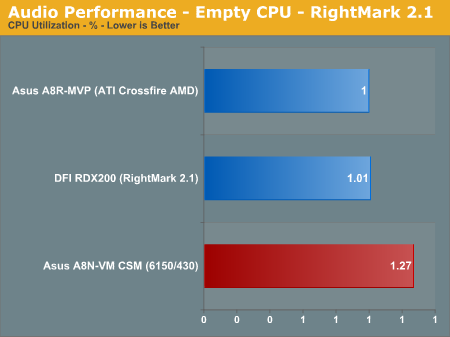
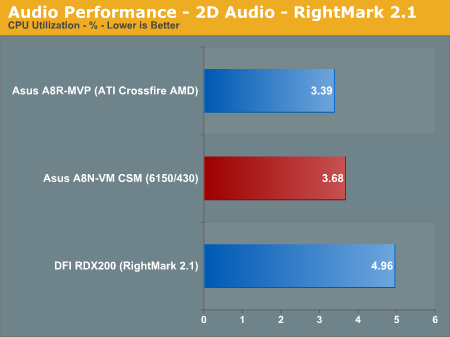
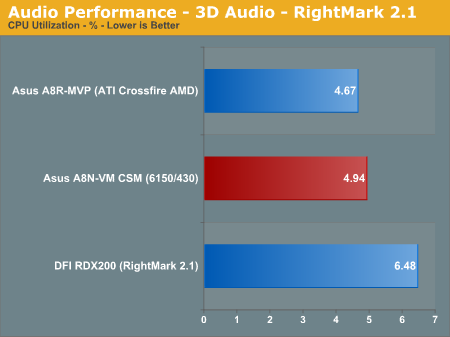
It is very important to point out that NVIDIA only provides HD audio for high-end AMD Integrated Graphics solution like this A8N-VM CSM board. There is no current NVIDIA HD option for nForce4 or nForce Dual x16 discrete chipsets for AMD processors. We are happy to see NVIDIA offering HD audio on the GeForce chipsets, and we hope that they will soon offer similar or better solutions for their discrete chipsets.
Ethernet Performance
Asus used the hooks in the 430 Southbridge to provide Gigabit LAN on the A8N-VM. Since this was the first time we had seen the Marvell 88E1111 PHY, we decided to test the performance of the on-board Ethernet.
The Windows 2000 Driver Development Kit (DDK) includes a useful LAN testing utility called NTttcp. We used the NTttcp tool to test Ethernet throughput and the CPU utilization of the various Ethernet Controllers used on the AMD motherboards.
We set up one machine as the server; in this case, an Intel box with an Intel CSA Gigabit LAN connection. Intel CSA has a reputation for providing fast throughput and this seemed a reasonable choice to serve our Gigabit LAN clients. At the server side, we used the following Command Line as suggested by the VIA whitepaper on LAN testing:
Ntttcps -m 4 ,0,‹client IP› -a 4 -l 256000 -n 30000On the client side (the motherboard under test), we used the following Command Line:
Ntttcpr -m 4 ,0,‹server IP› -a 4 -l 256000 -n 30000At the conclusion of the test, we captured the throughput and CPU utilization figures from the client screen.
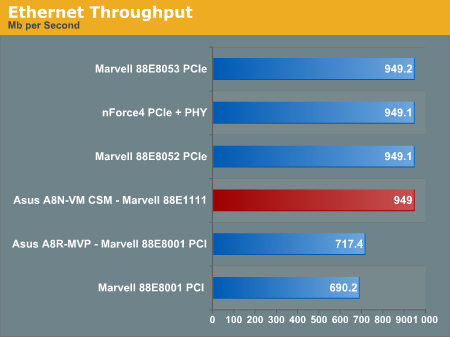
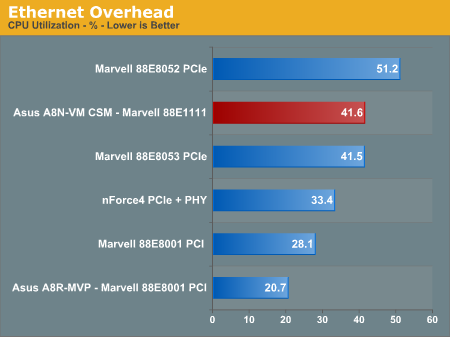










56 Comments
View All Comments
formulav8 - Sunday, December 4, 2005 - link
Speak for yourself.jfreiman - Thursday, December 1, 2005 - link
What are the chances that this is not Asus' HTPC motherboard?Could they be developing another model for a home theater PC? -- If so, will it use the nVidia chipset?
As much as I want to use this board for my HTPC, I have to examine why Asus would not have - at the very minimum, included a spidif cable and TV out cable.
Something just doesn't fit in this picture.
-John
Calin - Friday, December 2, 2005 - link
I would like to have game performance compared to a single channel board using one of the current integrated graphic chipsets - there is a Biostar board for Socket 754 and a Asrock one. Or at least to have performance checked with a single DIMM (or two DIMMs in single channel mode)Thanks
jamawass - Thursday, December 1, 2005 - link
Poor implementation of a good idea by Asus.This chipset screams htpc, why have HD audio without out of the box spdif? Might as well have realtek audio. The S video out should also be standard with an optional component out dongle for those who need it. Add-on brackets take up pci openings on the case, quite a few htpc cases are microatx where these slots are a premium.ShadowVlican - Thursday, December 1, 2005 - link
aw man.... if only this board can OC...jfreiman - Thursday, December 1, 2005 - link
According to the picture of the motherboad the board you tested was 1.01.However, I just read that there is a 2.0 rev board. Are you aware of this? Do you know if this is accurate?
I can't find anything about this on the Asus site and would like to know about this before I get the final piece (motherboard/video) for my HTPC upgrade.
Thanks for the quick review, and I too would like to know more about it's CPU utilization during DVD and HDTV playback.
Again, thank you.
-John
PS. and if I missed it, what was the BIOS revision you used for your tests.
Gary Key - Thursday, December 1, 2005 - link
AMI 0506
plonk420 - Thursday, December 1, 2005 - link
may we see HL2 and MPEG2/WMV9 decoding benchmarks, please, Anand? also, how does one go about purchasing the addon card, and is it S-Video only, or is there hope for component out?BigLan - Thursday, December 1, 2005 - link
Does the nvidia firewall actually work on this board, or does it corrupt zip archives as have been reported with the nforce4?Leper Messiah - Thursday, December 1, 2005 - link
Performance is mediocore, features missing, can't OC. Guess I'll be sticking with a biostar 6100-T for my next F@H box.